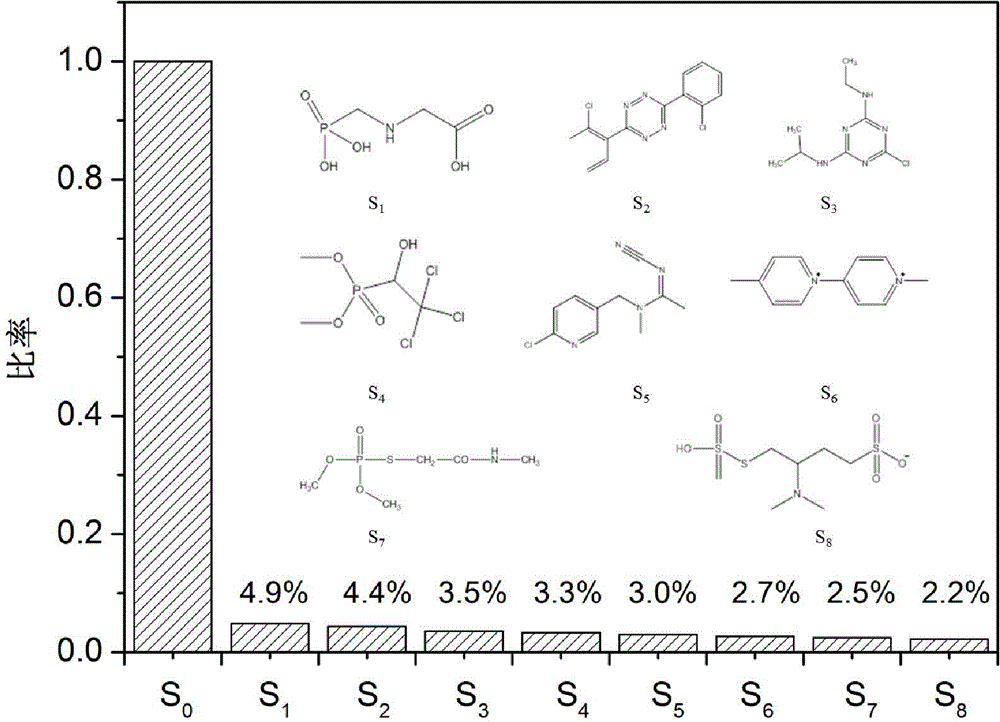Preparation method of aptamer photoelectrochemical sensor for high-sensitivity high-selectivity detection of MC-LR
A nucleic acid aptamer and MC-LR technology, which is applied in the field of photoelectrochemical analysis technology and environmental detection, can solve the problems of time-consuming analysis, high instrument price, and difficulty in achieving selective analysis, achieving high sensitivity and selectivity, and low price. Inexpensive, Ultra Sensitive and Selective Effects
- Summary
- Abstract
- Description
- Claims
- Application Information
AI Technical Summary
Problems solved by technology
Method used
Image
Examples
Embodiment 1
[0028] Construction of a highly sensitive and highly selective nucleic acid aptamer photoelectrochemical sensor for detecting water environmental pollutants MC-LR, using anodic oxidation method to prepare titanium dioxide nanotubes on titanium substrates, and modify cadmium sulfide nanoparticles to form shell polymers Sugar and glutaraldehyde are used to functionalize the surface of the electrode to construct a photoelectric biological interface, and chemically bond the MC-LR nucleic acid aptamer with a specific base sequence to the electrode surface to prepare the MC-LR nucleic acid aptamer photoelectrochemical sensor , the specific preparation process is as follows:
[0029] (1) The titanium plate is mechanically polished with sandpaper of different meshes in sequence until the surface of the titanium plate becomes a smooth mirror surface, and then placed in deionized water, ethanol, and deionized water solutions for ultrasonic cleaning for 15 minutes. Take out the titanium ...
Embodiment 2
[0035] (4) The prepared nucleic acid aptamer photoelectrochemical sensor was used as the working electrode, the saturated calomel electrode was used as the reference electrode, the platinum electrode was used as the counter electrode, and the PBS buffer containing 0.1 mol / L ascorbic acid was used as the electrolyte. Apply 0.0V bias voltage under visible light irradiation, and measure the i~t curve of the system after adding different concentrations of MC-LR continuously. Since the aptamer can specifically recognize MC-LR, when MC-LR is added to the electrolyte, MC-LR diffuses to the electrode surface to form a complex of MC-LR-aptamer, which prevents the ascorbic acid in the electrolyte from moving to the electrode surface. The electrode surface diffuses, thereby causing a decrease in photocurrent. Using the linear relationship between the photocurrent reduction value ΔI and the logarithm of the concentration of MC-LR, a working curve is established to realize the quantitative...
Embodiment 3
[0037] The prepared nucleic acid aptamer photoelectrochemical sensor was used as the working electrode, the saturated calomel electrode was used as the reference electrode, the platinum electrode was used as the counter electrode, and the PBS buffer containing 0.1 mol / L ascorbic acid was used as the electrolyte, and 0.0 V bias voltage, using the i~t curve method to measure the photocurrent of the mixed electrolyte solution added with MC-LR solution and 100 concentration of interfering substances in MC-LR. The selected interfering substances were glyphosate, tetrafenazine, atrazine, trichlorfon, acetamiprid, paraquat, omethoate, and monosultap. The results showed that when the concentration of interfering substances was 100 times that of MC-LR, the interference on the photocurrent of MC-LR was less than 5%. It can be seen that since the nucleic acid aptamer can specifically recognize the MC-LR molecule, the prepared nucleic acid aptamer photoelectrochemical sensor shows high se...
PUM
 Login to View More
Login to View More Abstract
Description
Claims
Application Information
 Login to View More
Login to View More - R&D
- Intellectual Property
- Life Sciences
- Materials
- Tech Scout
- Unparalleled Data Quality
- Higher Quality Content
- 60% Fewer Hallucinations
Browse by: Latest US Patents, China's latest patents, Technical Efficacy Thesaurus, Application Domain, Technology Topic, Popular Technical Reports.
© 2025 PatSnap. All rights reserved.Legal|Privacy policy|Modern Slavery Act Transparency Statement|Sitemap|About US| Contact US: help@patsnap.com


